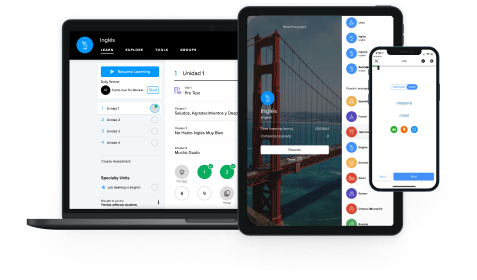
No matter your cultural background, may the luck of the Irish be with you this St. Patrick’s Day! However you’re planning celebrate the holiday, let Mango Languages equip you with some lucky phrases. You’re sure to be a hit at your St. Patrick’s Day party!
The Irish language varies depending on where you are in Ireland. The three main dialects are Munster in the South, Connacht in the West, and Ulster in the North. There are some differences in pronunciation, grammar, and vocabulary, but people can still understand each other (to learn more, check out our Irish language course). Although the following phrases may vary a bit, people will still know that you are speaking Irish. By speaking these phrases in particular, you just might bring good luck to the listener.
“Sláinte! (SLAAN-tye!)” — Cheers! Literal meaning: ‘Health’
St. Patrick’s Day parties have a reputation for being full of revelry, friends, and, of course, alcohol. To better prove your Irish know-how, use the Irish word for ‘cheers’ next time you toast before taking a swig of Guiness or uisce beatha, an Irish word that was shortened to ‘whiskey’ in English. This is not to be confused with the Scottish drink, ‘whisky’ (without the ‘e’).
In the Irish language, uisce beatha(whiskey→ lit. water of life)(You might not want to down it like water though.) If you’re really feeling brave on March 17, another traditional Irish drink is poitín[POT-yeen] an extremely strong liquor traditionally distilled from potato skins (and illegal for many centuries). Use sláinte this St. Patty’s Day to wish someone good health. Cheers!
“Go raibh maith agat! (gu ro MAHH aht!)” — Thank you! Literal meaning: ‘May there be good at you’
The true test for you at the end of (or before) St. Patrick’s Day is if you can pronounce ‘thank you’ in the Irish language. By thanking someone in Irish, you are actually sending a blessing that means, ‘May there be good at you!’ If you are particularly thankful, you can say, Go raibh míle maith agat! (Thank you very much!), literally, ‘May a thousand good things be at you!’
Mango’s exclusive Understood & Literal Meanings feature conveys these ‘hidden’ meanings to enrich your understanding of a language. That’s also why it takes so many words to say ‘thank you’ in Irish!
To reply to a ‘thank-you’ being sent your way, say Go ndéana a mhaith duit!(You’re welcome!). This is also a wish for good fortune as Go ndéana a mhaith duit literally means, ‘May it do its good for you!’
“Dia duit! (DEE-u ghit!)” — Hello! Literal meaning: ‘God to you’
Like we mentioned above, the modern celebration of St. Patrick’s Day is seen as a holiday with lots of partying and drinking. However, it wasn’t always like this. St. Patrick’s Day was originally a way for Irish immigrants to keep their heritage alive while they were living abroad, celebrating St. Patrick, the patron saint of their nation.
The significant influence of this saint on the Irish language and culture can be seen in the religious references that have since been ingrained in daily life and conversation. St. Patrick is said to be responsible for converting the people of Ireland to Christianity (and banishing all snakes from the island), forever impacting Irish culture and language. To reply to ‘hello’ in the Irish language, say Dia is Muire duit). You are literally saying, ‘God and Mary to you!’
“Go n-eirí an t-ádh leat! (Guh NAH-ree on TAAH-laht!)” — Good luck! Literal meaning: 'That luck may rise with you'
There is a reason that you think of luck when you think of the Irish. There are countless phrases that wish luck on the listener. Therefore, it was difficult to narrow down one phrase for ‘good luck’ in the Irish language. Go n-eirí an t-ádh leat is one way of wishing ‘good luck’ which literally means, ‘That luck may rise with you!’
Another well-known phrase that wishes good fortune is go n-éirí an bóthar leat. This phrase loosely translates as, ‘may the road rise up to greet you,’ the first line in that famous Irish proverb that you may have heard. These phrases will mean even more to the listener if you can find a four-leaf clover for them! Fun fact: Even though the four-leaf clover is considered the symbol of all things Irish, the harp is the official symbol of the Republic of Ireland. Now you know why there’s a harp on every bottle of Guiness. Sláinte!
Bonus phrase: “Lá Fhéile Pádraig sona duit! (LAA ey-lu PAAD-rig SOH-na ghit!)” — Happy St. Patrick's Day to you! Literal meaning: ‘Happy Day of the Festival of Patrick to you’
Of course, how can you really wish someone a ‘Happy St. Patrick’s Day’ without knowing the Irish phrase itself? Use this handy phrase on March 17th to fill everyone with Irish cheer. As you may have guessed, the word Pádraig in this phrase is the Irish spelling of the name, ‘Patrick.’ It’s one of the most famous Irish names due to the legacy of Naomh Pádraig [PAAD-rig](St. Patrick) , the patron saint of Ireland. To hear how this phrase is pronounced in Ireland, check out this helpful video by Gaelchultúr. This just might be the most fitting phrase to learn for your next St. Patrick’s Day party, or Lá Fhéile Pádraig party.
We hope you’ll learn at least one of these phrases in preparation for St. Patrick’s Day! If you’d like to explore more Irish language and culture, check out Mango’s St. Patrick’s Day course. Click below to start learning some Irish phrases. Go n-eirí an t-ádh leat!(Good luck!)
Start Learning Irish